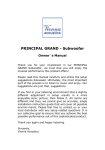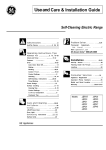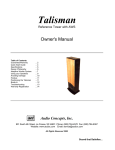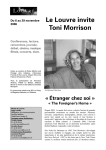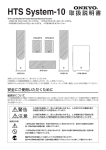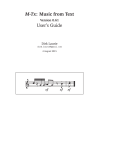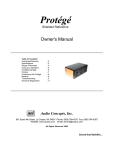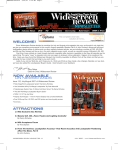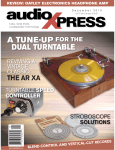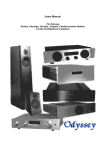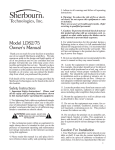Download Triad Speakers
Transcript
Triad InRoom Silver Subwoofer/ Satellite Speaker Ensemble Manufacturer: Triad Speakers, Inc. 15835 NE Cameron Boulevard, Portland, Oregon 97230; 503/256-2600; www.TriadSpeakers.com Price: InRoom Silver Monitor, $2,000 each; InRoom Silver Subwoofer (including outboard amplifier/ crossover), $1,400 each; OnWall Silver Surround, $600 each. Price for two-satellite, one-sub, one-amp package: $5,400. Price for two-satellite, two-sub, two-amp package: $6,800. Price for five-channel package, including three Silver Monitors, two Silver Subwoofers, two amplifier/crossovers, and two Silver Surrounds: $10,000. Source: Manufacturer loan Reviewer: Howard Ferstler Triad is a speaker company that some of you may not be familiar with. Like me, you may have seen ads for their systems in upscale audio and home-theater magazines for some time now, but in spite of this I have to confess that up until a short while ago I knew next to nothing specific about their products. I could not recall seeing a review anywhere (although I found out later that they had indeed been done), and the ads did not say much about the technologies involved or what kind of sonic performance niche the speakers were designed to fit into. It was easy to see from those ads that they were designed with considerations of visual style in mind, however, and the product line looked to be very stylish and well finished, and probably expensive. Consequently, I was enthusiastic when a full array of their “mid-priced,” in-room speakers was offered to me to review. Before getting down to the serious details, it will be necessary to describe each of the components in this package and outline their respective relationships to the others. The primary systems are the InRoom Silver Monitor satellites. These 16.25 x 7.3 x 8.5-inch systems (HWD, with the depth being 9 inches if the grill is included) are among the most solidly built speakers of any size I have ever encountered. The box weighs in at 24 pounds, and when I did both my knuckle-wrap and lift/heft analysis I wondered if they had any interior air space at all. The wood these units are constructed of is heavy duty to say the least, and the only satellite systems I have ever encountered that had enclosures as inert were the cast-aluminum, eggshaped Waveform MC satellites I reviewed in issue 84. The driver configuration installed in the Silver is rather basic, with a classic MTM arrangement that can be oriented either vertically or horizontally. The latter might be used if the system were placed on top of or underneath a TV monitor, but of course the problem with this is that any MTM horizontal arrangement is going to have problems with horizontal frequencyresponse lobing. These are superb satellites (more on this up ahead), and it seems a shame to set up the center unit in the all too common horizontal style. Of course, given the ten-grand list price for the full 5.1 array, it is obvious that the InRoom Silver package is not something that a typical cost-cutter would purchase. (Hey, although I previously said they were “mid-priced,” I meant that they were mid-priced compared to some other Triad models.) Indeed, most of those who would obtain this formidable array of systems probably either have a killer-grade, frontprojection video system or a low-profile plasma monitor that would allow for the center speaker to be wall mounted and oriented vertically for compatibility with vertically mounted left and right speakers. Getting back to the details, the tweeter is a oneinch, fabric-dome job made by SEAS, and it is flanked by five-inch Scanspeak, upper-bass/midrange drivers. (These units are the same drivers that Krell uses in its $37,500 per pair LAT-1 systems.) One-meter sensitivity is a rather high 92.5 dB (2.83 volts applied), the rated nominal impedance is 4 ohms (minimum 3.2 ohms), and the rated frequency response is 70 Hz to 20 kHz (+/- 3 dB), a clear indication that this is a satellite speaker and not a full-range system. The crossover network is a second-order job (12 dB high-pass and low-pass slopes), with the transition point at 2.5 kHz. All drivers are shielded for close-up use near a CRT-type monitor, and although the system is designed to handle power peaks of up to 200 watts, its minimum power rating of 50 watts means that you do not necessarily have to power each with a 60-pound monoblock. Indeed, the high sensitivity means that the systems can get quite loud with only moderate input power. The bottom part of the backside of the unit contains one set of high-quality, five-way binding posts. The stretched-cloth grill screens are held in place by unique fasteners that squeeze over the midrange driver mounting screws, and the grill frames are shaped in such a way that they will somewhat minimize diffraction effects. The system is available in a large variety of realwood finishes, as well as basic black or white, and the company will go so far as to match the color against any sample wood finishes you care to send to them. Needless to say, Triad takes the home-décor interests of its customers very seriously. These are not speakers that you would install in your garage or even a knockabout family room. Indeed, Triad is a rather unusual company. Rather than market through dealers who let customers take their systems home and set them up all wrong, they prefer to work with dealers who specialize in actually going to the customer’s abode and setting up the systems right and proper. Ironically, this is reason for the first of three complaints I have against what is essentially a very fine performing speaker package: the owner’s manual is not written for the careful individual who would use the information to do a good do-it-yourself installation. The instructions are often cryptic, and the amount of useful information not included is rather substantial. Clearly, this system is either for someone who wants a dealer-installed custom job or for an advanced audio enthusiast who is very adept at setting up and calibrating very high-quality loudspeaker systems from scratch. I would assume that at least some of this magazine’s readers occupy the latter category. The two InRoom Silver Subwoofers are as impressively built as the satellites. Like the satellites, they are on the small side, considering what they are able to do, being 16.4 x 15.5 x 14.5 (HWD), with a weight of 60 pounds. Each contains a twelve-inch, cast-basket woofer that has a heavy paper cone and a three-inch voice coil. Hookups are on the back, via five-way binding posts that unfortunately will not accept banana plugs of any kind, because of the way they are positioned. They will accept bare wires, pins, and spades, however. Like the satellites, the sub cabinet is available in numerous finishes. While the sub is available with a built-in amplifier, the pair sent to me were unpowered. To make up the difference, Triad supplied two custom-built outboard amps that are designed to fit into your equipment rack. Each of these 15-pound monoblocks is 3.75 x 16.6 x 13 (HWD, with the connectors on the back and the knobs on the front adding an additional 1.25 inches to the depth), and each can generate 250 watts of power into the 4-ohm load presented by each subwoofer. The front panel contains an on/off switch (with an LED to indicate a power-on condition), continuous level and phase controls, and two low-pass filter controls. Each of the latter makes use of second-order lowpass filters that cover a range from 35 Hz to 250 Hz. The user can set the two controls identically to generate a simple 24 dB slope at one frequency, or can stagger the frequencies to custom-contour the low-pass slope. In spite of the complexity of the low-pass circuitry, the high-pass section makes use of a simple 100 Hz, second-order filter. Given the size of the satellite midrange drivers and the need for them to be able to play quite loud in larger rooms, this is probably a good choice. Unfortunately, the second complaint I have against the Triad package involves those four front-panel controls (level, phase, and two filters) The “knobs” themselves are so skinny that it is hard to use them. Indeed, they almost look like potentiometer shafts that are missing proper knobs. Because of their very small size, it is nearly impossible to see how they are adjusted, meaning that if you accidentally move one away from its setting you will have a devil of a time fixing things without hauling out test equipment and re-doing the calibration. In addition, the main level control is so abrupt in its action that merely moving it a fraction of a degree causes a substantial jump in subwoofer output. Supposedly, these controls are going to be changed in the future, and let’s hope that future happens pretty soon. In the meantime, if you have a pro calibrate those levels and crossover settings for you, keep your fingers off the controls after he leaves. The back panel of each amplifier has two, gold-plated five-way speaker-out hookups, two gold-plated linelevel-in jacks and two line-level, high-passfiltered out jacks, all of which might be used if you installed the unit between a preamp and stereo power amp. There are two of each, because you could use the amp to power a single sub if the room was not large. If you use two amps and two subwoofers (best if you have a fairly big room), you would just one input and output. In addition to those standard sub-amp connections, there is a line-level connection labeled Theater In. Now, this s supposedly what you would use if you hooked the unit up to the sub-out jack on a surround processor or A/V receiver. The latter would have its own low-pass section, and you would not use the Triad amplifier’s high-pass-out jacks at all. The front-panel controls would all continue to work, however, and you could fine tune the processor’s own low-pass filtering with additional slope contouring. Or, you could turn each low-pass control up to their 250Hz maximum and essentially have a crossover bypass switched in. Unfortunately, I have a beef with the Theater In hookup, and that involves my third complaint against the system: Theater In applies THX-style contouring to the low-end of the frequency spectrum, which means that the bass is electrically rolled off below about 35 Hz. While this kind of situation would be OK for many (but certainly not all) movies, it would be a real stinker for musical programs that had an abundance of extremely low bass. This would shortchange both the listener and also shortchange the capable Triad Silver subwoofers. I got with Triad about this, and noted that if somebody wanted to get full-spectrum bass from the system while using the subwoofer-out feature of their surround processor, they would be better off using one of the line-in jacks. This is because the standard inputs will not engage the circuitry that rolls off the deep bass the way the Theater In hookup does. Triad indicated that standard line-in connection can be used by customers wanting linear bass response all the way down, and that dealer installers would be aware of this. (The manual makes no mention of this hookup option, however.) The Theater In hookup is only for those who intended to mainly use the system for home theater and music that did not have strong bottom-end bass. So if you get the Triad package and want serious deep bass from those fine Triad subwoofers, remember to not use the Theater In hookup. Instead, use one of the line-in feeds, with a Y-connector splitting the signal to both sub amps if dual subs and a mono subwoofer output are involved. The last items included in the Triad InRoom Silver package were the two semi-dipolar surround speakers. These units each contain a 6.5-inch Vifa midrange driver and two 3-inch Vifa cone tweeters, mounted in a 13.5 x 13.5 x 3.6 inch (HWD), truncated triangular enclosure, with the midrange facing outward and each of the tweeters on side-angled panels. While surround speakers with this kind of driver arrangement are not unusual, the enclosure itself is, because it is designed strictly for wall mounting. There are notches for the wall mounting screws (not supplied) built into flanges at the top and bottom of the box, and once the unit is securely in place a special grill assembly can be snapped into position to cover the entire assembly. These are dedicated left/right units, with one for right-side mounting and the other for left-side mounting. Because a single midrange driver cannot be dipolar in behavior, the overall dipolar effect of these speakers is subtle, compared to what you would get with two complete midrange/tweeter sets being wired out of phase. I was not about to drill holes to mount the systems, but a bit of experimental stand building solved the problem when it came time to arrange them for evaluation. The Triad amplifiers are warranted for three years. The speakers are warranted for 10 years. To get an idea of just how good this package would sound in a full-blast surround-sound installation, I set up all of them in my 3,400 cubic foot main A/V room and drove them with the Onkyo TX-DS787 receiver I reviewed in issue 86. The results were sensational, to say the least. I tried a number of fine recordings with this combination, first listening in straight stereo and then making use of the Onkyo’s “Orchestra” surround mode. The classical releases included Kaleidoscope (Summit 317), a finely recorded medley of trumpetsolo works by Albinoni, J.S. Bach, Ravel, Dello Joio, and others; An American Requiem, by Richard Danielpour (Reference Recordings 97), a close-up sounding, clean and detailed choral/orchestral presentation; and Cantiones Sacre Quinis Vocibus, by Peter Philips (Naxos 8.555056), a superb choral presentation. Somewhat more pop-oriented fare included The Persuasions Sing the Beatles (Chesky JD220), a superbly recorded, mostly a cappella tribute to the group, and Danzón, performed by the Turtle Island String Quartet (Koch 7529), a remarkably well recorded combination of jazz and “experimental” music. All I all, the results were exceptional, with stereoonly playback seemingly able to qualitatively match some of the best controlled-dispersion speakers I have auditioned in the past. Basic listening can tell one a lot about a fine group of speakers. However, one other way I have found to evaluate a speaker package subjectively involves careful A/B comparisons between the test set and another fine stereo pair. To pull out all the stops, I chose three different stereo-speaker combinations to do my comparing, and did the face off over a several-day period, making a point of carefully level matching each combination. The Triad satellites were powered by a pair of Sherbourn 1/300MB amps, and each contending pair was in turn powered by a Yamaha DSP-A1000 integrated unit (operating in stereo), allowing me to easily match average levels. The preamp was a Carver C-1 and the player was the Pioneer DLV-700 super combi DVD/LD/CD unit I reviewed in issue 66. A Radio Shack tape switcher between the preamp and the amps acted as the A/B controller. A set of Dunlavy LCR Ultra speaker cables connected the amps to the Triads, and the cables to the contenders were Carol Wire Company 12 AWG stranded. Interconnects were fairly long Radio Shack Gold leads going to and from subwoofer amps and satellite amps. While some might contend that this would cause audible problems, in my experience, interconnect runs of this kind work just fine. While it is difficult to do a proper A/B comparison with two pairs of speaker systems, due to the systems being offset in space, I did stagger the sets in A/B - A/ B form, and paid careful attention to getting them proper distances from the primary listening position. Imaging would be somewhat compromised, of course, but the overall spectral balance and soundstaging would not be too seriously compromised by this kind of arrangement. The first challenger was a pair of very new NHT M6 satellites and P6 stands, with a list price of $1,600. (A review by me of these, along with the NHT U1 subwoofer system, should be showing up soon in The Audiophile Voice). To handle the low bass, I included an updated version of the $850 SVS 16-46PC subwoofer that I reviewed in issue 88. This bumped the package price up to $2,450. The sub’s built-in crossover was used. The second was a pair of AR Phantom 8.3 systems (reviewed in issue 82), with a list price of $1,500 per pair on their stands. These were augmented by a $2000 Velodyne F1800RII subwoofer (reviewed in issue 67), which brought the package list price up to $3,500. The F1800RII is discontinued, but the HGS-18 replacement has similar performance, although its list price would bring the package list price up to $4,500. The sub’s builtin crossover was used. The third was a pair of Dunlavy Cantata systems (reviewed in issue 87), running full-range and with a list price of $5500. The Cantata has been discontinued, but is for all intents and purposes sonically identical to the new SC-IIIa model. To make the comparison a bit more financially equitable, I used only one Triad subwoofer and outboard amp/crossover with the Triad satellites, bringing that combination’s list price to $5400. All comparisons were done in my 3,400 cubic foot main listening room. OK, so what kind of results did I get? Well, to be truthful, the Triad package held its own rather nicely. In addition to the recordings mentioned previously, I used a technically superb recording of Mendelssohn’s Piano Trios, 1 and 2 (Naxos 8.555063) and a very good recording of Fauré’s Pelléas et Mélisande (Koch 7348). Close comparing was also done with my old standby, the Engineer’s Choice II disc (Delos 3512), which contains a grab-bag of excerpts recorded by John Eargle. I also did some comparing with a terrific rock recording, Dire Straits On Every Street (Warner 22680). A newcomer to my evaluation-disc collection is the Test CD-1, available from the Boston Audio Society for $40 by simply contacting [email protected]. (The payment also gets you a one-year membership in the Society, which publishes a very informative magazine.) One track on this disc has an excerpt from St. Saëns Symphony Number Three that will show off the abilities of any top-tier subwoofer, and there are some exceptionally well recorded other pieces as well, plus some useful test signals. Note that this is a CD-R disc, meaning that many DVD players will not be able to play it. The Pioneer DVL-700 had no problems, however. There were subtle differences between the Triad package and the AR/Velodyne package with all of these discs, with the Triads often sounding a tad more detailed and yet just a bit less edgy, and also exhibiting somewhat better imaging at dead center. Against the NHT/SVS package the result was often a near tie. Indeed, it was often difficult to tell the two arrangements apart, although at times the NHT units seemed a bit more spacious sounding. In contrast, the Triads appeared to better pinpoint centered soloists and also bring them in a bit closer. The biggest differences between all three pairs involved the middle bass, where the different locations of the satellites and subwoofer systems in relation to room boundaries had an impact on the richness of such instruments as cellos. The Dunlavy comparison was a revelation. At time, they sounded so similar to the Triads that I thought that maybe my switch controller was acting up. There were differences, but on material like guitars and massed strings there was just no way to assign a winning score to either. This kind of so-close performance, particularly in the midrange, was a first in my experience. In terms of bass performance, things were pretty much the same down into the fairly low bass range. However, down really low the single Triad sub was no match for either the big Velodyne or the SVS, even at only moderately loud levels. However, below 40 Hz it did manage to musically hold its own with the dual ten-inchers installed in the Cantatas. To take advantage of its full subwoofer package, I hooked up the second Triad sub and amp and the subwoofer combination was a subjective near match for the Velodyne and SVS units, even at fairly high levels. Later in the week, I set up the Triad package all by itself and did some room-response measurements with my AudioControl SA-3051 RTA. As usual, I employed my moving-microphone technique, with the RTA doing a 20-second integration with an uncorrelated, stereo pink-noise signal. The results were quite good, with an impressive +/- 2 dB deviation between 250 Hz and 16 kHz, with even the dip in the range where the tweeter and midrange units dovetail being smaller than typical. Below 250 Hz, the response was increasingly dominated by room modes, but I still managed to get a fine integration between the subs and the satellites, thanks to the flexibility of the Triad crossovers built into the sub amps. Interestingly, I pulled out a copy of the response curve I ran on the Dunlavy systems some time back, and it was remarkably similar to what I got with the Triad package. This somewhat explained why the systems, which have similar radiation patterns, sounded so borderline identical above the low-bass range during my A/B comparisons. The AR and NHT curves were not quite as close, but they were still in the ballpark. Let’s face it, some loudspeaker systems are getting pretty darned good, and the more good they get the more alike they are going to sound, at least in terms of spectral balance, clarity, detail, and sometimes even soundstaging. In terms of flat response into the low-bass range, as I previously indicated, the two Triad subs approached the performance of the bigger Velodyne and SVS models, and were also close to a Hsu VTF-3 I had on hand. Not quite as flat down really low, but impressive, nonetheless. Their maximum-output abilities were also impressive, thanks to the coherent gain possible when using two units. With my usual maximum-output tests (subs each located about 14 feet away, in my main room), the pair could hit 110 dB at 31.5 Hz and 100 dB at 20 Hz. In contrast (corner located, 17 feet away), the F1800RII could hit 114 and 110, the SVS could hit 113 and 102, and the VTF-3 (set for maximum extension) could hit 112 and 100. In terms of subjective performance with musical material, even material with substantial low-bass content, the readings I took are not as critical at they might seem. With high-impact musical and hometheater sources, a pair of Triad InRoom Subwoofers should be able to run with all of the subs I mentioned, and do so up to fairly high output levels. So, what do I think of the Triad InRoom Silver packages? Well, I think they are pretty sensational. The fit and finish is impeccable and the sound quality is up there with the best I have previously auditioned, although the owner’s manual needs work if the company expects hobby enthusiasts to play with their products, and the controls on the amplifier front panel need to be refined. However, a competent enthusiast (or dealer) can deal with those minor deficiencies. These are remarkable systems, and if there is a Triad dealer nearby, you owe it to yourself to see what they offer. -HF T$S Excerpted -with permission from The Sensible Sound, Issue #93 Nov/Dec 02. Subscriptions to TSS can be purchased by calling 1-800-695-8439






